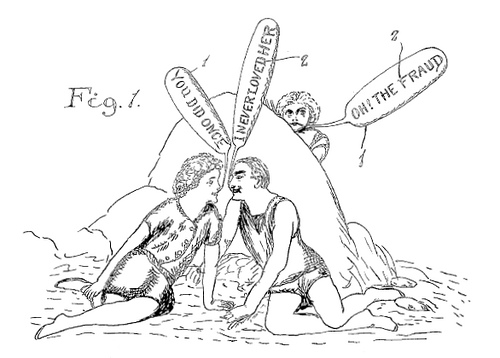“Patriotism is your conviction that this country is superior to all other countries because you were born in it.” — George Bernard Shaw
“Be Good, Be Good. A Poem.”
Be good, be good, be always good,
And now & then be clever,
But don’t you ever be too good,
Nor ever be too clever;
For such as be too awful good
They awful lonely are,
And such as often clever be
Get cut & stung & trodden on by persons of lesser mental capacity, for this kind do by a law of their construction regard exhibitions of superior intellectuality as an offensive impertinence leveled at their lack of this high gift, & are prompt to resent such-like exhibitions in the manner above indicated — & are they justifiable? alas, alas they
(It is not best to go on; I think the line is already longer than it ought to be for real true poetry.)
— Mark Twain
The Ulam Spiral
Write the numbers from 41 to 440 in a square spiral:

Remarkably, all the numbers on the red diagonal are prime — even when the spiral is continued into a 20 × 20 square.
No one’s quite sure what to make of this. Polish mathematician Stanislaw Ulam discovered the pattern while doodling at a scientific meeting in 1963.
A Bad Night
Description of the bed chamber of countess Cornelia Bandi as discovered by her maid one morning in 1731, reprinted in the Philosophical Transactions of the Royal Society of London, 1745:
Four feet distance from the bed there was a heap of ashes, 2 legs untouched, from the foot to the knee, with their stockings on: between them was the lady’s head: whose brains, half of the back part of the skull, and the whole chin, were burnt to ashes; among which were found 3 fingers blackened. All the rest was ashes, which had this particular quality, that they left in the hand, when taken up, a greasy and stinking moisture.
… The bed received no damage; the blankets and sheets were only raised on one side, as when a person rises up from it, or goes in; the whole furniture, as well as the bed, was spread over with moist and ash-coloured soot, which had penetrated into the chest-of-drawers, even to foul the linens; nay the soot was also gone into a neighbouring kitchen, and hung on the walls, moveables, and utensils of it. From the pantry a piece of bread covered with that soot, and grown black, was given to several dogs, which refused to eat it.
“It is impossible that by any accident the lamp should have caused such a conflagration,” remarks the correspondent. “There is no room to suppose any supernatural cause. The likeliest cause then is a flash of lightning.”
In a Word
spanghew
v. to launch a frog or toad into the air
Sighs and Whispers

Frustrated with the intertitles in silent films, Charles Pidgin invented a better solution in 1917: The performers would inflate balloons on which their dialogue was printed. “The blowing or inflation of the devices by the various characters of a photo-play will add to the realism of the picture by the words appearing to come from the mouth of the players,” Pidgin wrote. Even better, “the size of the speech may be increased with the increase of various emotions depicted on the screen.”
It’s not too late to implement this.
Cookie-Cutter Holes
On Nov. 24, 1984, the Spokane, Wash., Spokesman-Review reported the discovery of a massive chunk of earth, 10 feet long by 7 feet wide, that had somehow been plucked from the ground and put down, right side up and intact, 73 feet away. Roots had been torn apart rather than cut, and, strangely, the debris between the hole and the slab traced an arc rather than a straight line.
“All we know for sure is that this puzzle piece of earth is 73 feet away from the hole it came out of,” said geologist Greg Behrens.
Similar “cookie-cutter holes” have been observed elsewhere; the earliest known reference is in the Royal Frankish Annals of the 8th century:
In the land of the Thuringians, in the neighborhood of a river, a block of earth fifty feet long, fourteen feet wide, and a foot and a half thick, was cut out, mysteriously lifted, and shifted twenty-five feet from its original location.
No doubt there’s a mundane explanation for this, but for now no one knows what it is.
One-Note Sentences
Monotonous conversation from around the world:
Finnish:
Etsivät etsivät etsivät etsivät etsivät.
“The searching detectives are searching the searching detectives.”
Spanish:
¿Cómo como? ¿Cómo cómo como? Como como como.
“How do I eat? What do you mean, how do I eat? I eat how I eat.”
Icelandic:
Ái á Á á á í á.
“A farmer named Ái, who lives on a farm by the name of Á, owns a female sheep that is in a river.”
Malay:
Sayang, sayang sayang sayang, sayang sayang sayang?
“Darling, I love you, dear, do you love me?”
Romanian:
Stanca sta-n castan ca Stan.
“Stanca stood in a chestnut tree like Stan.”
Hungarian:
A követ követ követ.
“The envoy follows a stone.”
Tagalog:
Bababa ba? Bababa!
“Going down? It is!”
The Self-Flowing Flask

Denis Papin described this perpetual motion scheme in 1685. The pint of liquid in the goblet weighs more than the ounce in the tube, and so forces it down. When the liquid spills out the top of the tube and back into the goblet, it starts a cycle that must continue until the liquid finally evaporates. Where is the error?
Trivium
Men are struck by lightning four times as often as women.
